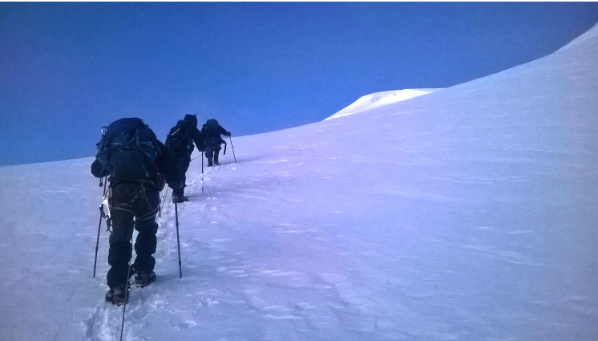Mera Peak (6,476 meters / 21,247 feet) stands as one of Nepal’s most popular trekking peaks. Located in the Khumbu region, it offers climbers the chance to summit one of the highest trekking peaks in the world while being surrounded by breathtaking views of the Himalayas. Although technically considered a “trekking peak,” Mera Peak climbing presents challenges due to its altitude, terrain, and weather conditions. This makes it an ideal option for those seeking a non-technical, yet thrilling Himalayan climbing experience.
Why Climb Mera Peak?
Mera Peak climbing is often favored by trekkers looking to step up their mountaineering skills without venturing into the more technical, high-altitude peaks like Everest or Lhotse. Despite its classification, the climb requires a basic understanding of mountaineering techniques such as the use of crampons, an ice axe, and knowledge of how to deal with altitude sickness. It’s perfect for trekkers who have prior high-altitude trekking experience and those who are looking for a manageable yet rewarding climbing challenge.
The primary attraction of Mera Peak is not only the climb itself but also the exceptional panoramic views that climbers are treated to. From the summit, climbers can see some of the highest peaks in the world, including Mount Everest, Lhotse, Cho Oyu, and Makalu. The relatively low number of climbers compared to other Himalayan peaks ensures that Mera Peak provides a more tranquil experience in one of the most beautiful regions in the world.
Climbing Route Overview
Mera Peak climbing typically takes 12 to 18 days, depending on the route and acclimatization needs. The journey begins with a flight from Kathmandu to Lukla, followed by a trek to the base camp. During this time, trekkers gradually gain altitude, trekking through Sherpa villages, rhododendron forests, and alpine meadows to prepare their bodies for the challenges ahead.
The base camp is located at an altitude of 5,300 meters (17,388 feet). From here, climbers proceed to higher camps—Camp I at 5,800 meters (19,029 feet) and Camp II at 6,000 meters (19,685 feet)—before making the final push to the summit. Most climbs are done in the early morning hours to take advantage of stable weather conditions. While the route involves some technical terrain, such as snow and ice-covered slopes, it remains achievable for climbers with prior trekking and mountaineering experience.
The Summit Push
The summit day is often a long, strenuous day, requiring climbers to start early in the morning to avoid the intense afternoon winds and to reach the summit during daylight hours. The final ascent requires careful navigation of snow and ice-covered sections. Using crampons and ice axes, climbers make their way up the summit ridge, where they are rewarded with incredible views of the Everest region. Once at the summit, the sense of achievement is overwhelming, with an awe-inspiring 360-degree panoramic view of some of the highest mountains on the planet.
What to Expect
Climbing Mera Peak requires physical stamina and mental preparation. While it is technically a non-technical climb, the altitude and weather can present serious challenges. Proper acclimatization is critical to avoiding altitude sickness, and climbers should take adequate time to adjust to the thinning air. Additionally, the weather can change rapidly in the Himalayas, so packing proper gear is essential for a safe and comfortable climb.
Conclusion
Mera Peak climbing offers a unique opportunity for climbers looking to test their skills and experience the Himalayas in all their grandeur. It is a great way to challenge yourself while taking in some of the most spectacular mountain views in the world. While the climb is less technical than some other peaks in Nepal, it is not without its challenges. Success on Mera Peak depends on good preparation, proper gear, and attention to altitude acclimatization. Reaching the summit provides a rewarding sense of accomplishment and an unforgettable adventure in the heart of the Everest region.
Key FAQs about Mera Peak Climbing
- Do I need previous climbing experience for Mera Peak?
While prior mountaineering experience is not mandatory, it is highly recommended. You should have previous experience with high-altitude trekking and basic mountaineering skills, including using crampons and an ice axe. - How difficult is Mera Peak to climb?
Mera Peak is considered a “trekking peak,” which means it is less technically demanding than many higher Himalayan peaks. However, the climb still presents challenges, including high altitude, weather conditions, and some sections of ice and snow. Physical fitness and proper acclimatization are crucial for success. - What is the best time to climb Mera Peak?
The best time to climb Mera Peak is during the pre-monsoon (spring) season, from March to May, or the post-monsoon (autumn) season, from September to November. During these months, the weather is generally stable, offering clear views and safe climbing conditions. - How long does it take to climb Mera Peak?
The climb generally takes between 12 to 18 days, depending on the specific route and acclimatization schedule. - Do I need a guide to climb Mera Peak?
Yes, it is highly recommended to have a professional guide and support staff for Mera Peak climbing. Nepalese government regulations require all trekkers to be accompanied by a certified guide or permit holder. Guides not only provide safety and expertise but also ensure logistical support throughout the trek and climb. - What gear is required for Mera Peak climbing?
Essential gear includes warm clothing, mountaineering boots, crampons, an ice axe, a helmet, and high-altitude equipment like a sleeping bag rated for extreme cold. It’s important to have appropriate layers for varying weather conditions, as well as personal safety equipment like a first-aid kit, trekking poles, and water purification tablets.

